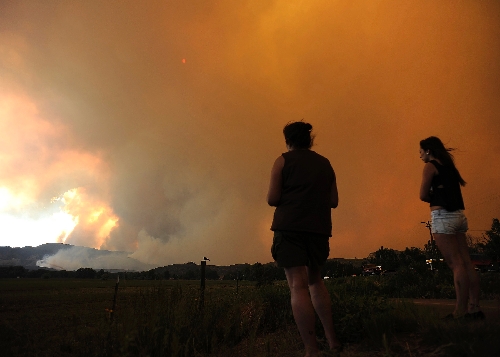Fires force hundreds to flee in Colorado, New Mexico
LOVELAND, Colo. - Firefighters on Sunday battled wildfires that have spread quickly in parched forests in Colorado and New Mexico, forcing hundreds of people from their homes and the evacuation of wolves from a sanctuary.
The Colorado fire, burning in a mountainous area about 15 miles west of Fort Collins, grew to more than 31 square miles within about a day of being reported and has destroyed or damaged 18 structures.
In southern New Mexico, strong winds grounded aircraft fighting a 40-square-mile wildfire near the mountain community of Ruidoso. Crews were building a fire line around the blaze, which started Friday and has damaged or destroyed 36 structures.
It wasn't immediately clear how many of the structures lost were homes.
"We're still trying to take a tally," Kerry Gladden, public information officer for Ruidoso, said late Sunday afternoon.
In Colorado, the fire sent up heavy smoke, obscuring the sun and creating an eerie, orange dusk in the middle of the day. The smell of smoke drifted into the Denver area, and smoke spread as far as central Nebraska, western Kansas and Texas.
The latest New Mexico fire is smaller than the Whitewater-Baldy fire - the largest in the state's history - but it's more concerning to authorities because it started closer to homes, said Dan Ware, a spokesman for the New Mexico State Forestry Division. He said the number of Ruidoso evacuees was in the hundreds.
Gladden said preliminary evacuations could be issued for some areas closer to town due to wind shifts.
Karen Takai, a spokeswoman for the Ruidoso fire crews, said smoke is heavily affecting the community of Capitan, about five miles to the northeast. She said Capitan and others could face evacuation.
"Any communities around this fire have the potential of being evacuated," she said. "If I lived in Capitan, I definitely would be prepared. Don't wait until the sheriff's office comes knocking at your door and tells you to evacuate."
Elsewhere, firefighters contained a 10-square-mile wildfire on the Utah-Nevada border where a firefighting air tanker crashed last weekend, killing both crew members. Cooler weather helped firefighters in their battle against two wildfires in southern Utah.
The lightning-caused White Rock Fire in eastern Nevada and western Utah, about 150 miles northeast of Las Vegas, was 100 percent contained Friday night after a weeklong battle, officials said. Most of the fire was in Nevada.
Crews also were battling a 1,200-acre wildfire Sunday in Tooele County near the Nevada line. It was 40 percent contained. The cause of the fire, which began Saturday, is under investigation.
Also Sunday, firefighters battled a wildfire that blackened 6 square miles in Wyoming's Guernsey State Park and forced the evacuation of 500 to 1,000 campers and visitors.
In Colorado, authorities sent nearly 1,800 evacuation notices to phone numbers, but it wasn't clear how many residents had to leave. About 500 people had checked in at Red Cross shelters. Larimer County Sheriff Justin Smith said there was an unconfirmed report of a person unaccounted for, but he wouldn't elaborate.
Authorities say it is the worst fire seen in Larimer County in about 25 years. It spread as fast as 1½ miles an hour Saturday, skipping over some areas but burning intensely in trees in others. Flames were coming dangerously close to deputies who were telling some residents to evacuate, Smith said.
Kathie Walter and her husband helped friends several miles away evacuate from the Colorado fire on Saturday. When they got home, they were surprised to get a call warning them to be ready to evacuate just in case. But Walter didn't want to wait.
"Smoke was coming in hard. We could not see flames or orange or black smoke. But we didn't need to see anymore. We just said 'Hey, let's get out of here,' " she said.
They evacuated with their five cats and two dogs. They had a head start. After a wildfire in the area last year, they left two suitcases packed in their garage.
The blaze also forced the evacuation of 11 wolves from a sanctuary near the fire. KUSA-TV in Denver reported that 19 wolves remained behind at the sanctuary, which has underground concrete bunkers known as "fire dens" that can be used by the animals.

















